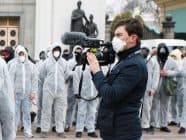As part of our series celebrating ten years of the EJO, award-winning photojournalist Hazel Thompson speaks to Marcello Foa. Thompson’s work has appeared in several publications including The New York Times, Vogue, The Sunday Times and Stern Magazine. One of her most significant works is Taken, an expose of the Indian sex trade, that she has worked on for a decade.
Digital media are reshaping journalism and traditional media are suffering more and more. Is it the same for Photojournalism?
Thompson: I agree that digital media is reshaping journalism and print media is suffering. For photojournalism this change has really affected budgets for assignments and getting long term projects funded, due to less advertising revenue and media still unable to make money from online platforms. It’s getting harder and harder each year for photographers to make a living purely out of photojournalism, with less assignments and rates not going up for over 10 years and cost of living increasing. Photojournalists now need to go beyond the journalism arena to fund projects and look into creative ways to fund projects. I approached companies and grants to fund my ebook TAKEN. I do think a positive of digital media is that it has opened up new platforms to communicate to a wider audience and given new creative ways to tell a story.
In the era of Instagram do you believe there is still appetite for high quality photojournalism?
Thompson: I think Instagram has increased the publics appetite for visual documentation, which I think is exciting as we can use it as a tool to reach a new audience, especially reaching the younger generation with subjects they would not normal engage with, such as human rights issues etc. I think the digital age, photoshop, social media and iPhone photography has affected the public’s understanding of how much ‘high quality’ photojournalism costs though and the easy free access to images online has caused people not to value photography as before. I do think the public see when an image is of a high standard and is professionally photographed, but sadly the easy access to free images online means people are not willing to pay for it.
You have always been engaged in “humanitarian reportage”. What drives you and what kind of reward are you looking for?
Thompson: My main drive for humanitarian reportage is the story itself and the people I meet and photograph. I am an optimist and do believe exposing the truth on camera will open the public’s eyes to want to make a
difference. My greatest reward and encouragement to keep doing this kind of work is to see how people respond to a story and are inspired to act, whether donating money to a charity, to personally Campaign and raise awareness. I believe I haven’t done my job as a visual communicator if there is no response to a story. My images should be making an emotional connection with the viewer.
Would you still recommend young people to become professional photographers?
Thompson: I would recommend young people to become a photographer, as it’s an incredible job! But I would only recommend those who are really passionate and dedicated as it’s really tough out there and you need to be determined and self motivated to survive in the industry. I think young photojournalists need to be more prepared in the reality of being a self creative and business by Journalism schools, so to have a wider skill set to make it.
Photo by Philip Di Salvo, European Journalism Observatory
Tags: Hazel, Hazel Thompson, Journalism, media, News, photo, photographer, Photography, Photojournalism, Thompson














































